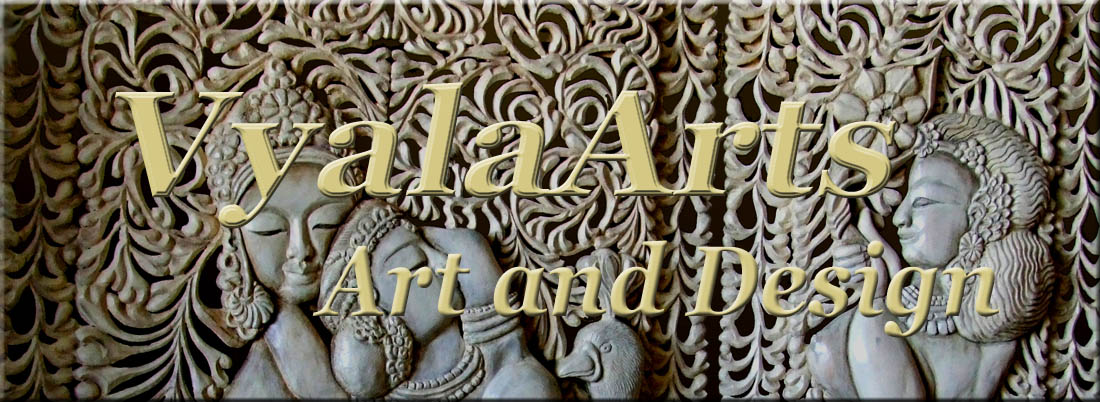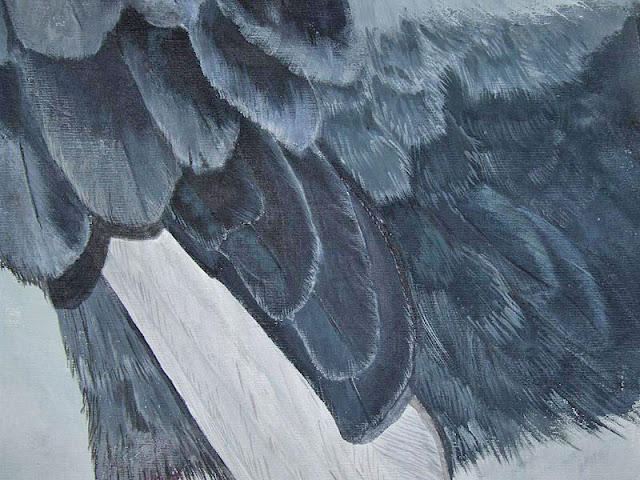The feet of Pete, the patriarch of our pigeon family are here portrayed again as well as part of his beautiful plumage.
He was an impressive pigeon man with incredibly broad shoulders and
beautiful feet with completely white nails. He went over the rainbow in
February 2011 and you can read his story
here and
here. I miss him still after so many years - he will always have a place in my heart.
Pigeons have many enemies and often sit between two chairs. For example there are other birds, which prey on pigeons such as the peregrine falcon, being the #1 enemy and then hawks. There is a declared hostility between crows and pigeons although crows normally are not able to catch pigeons unless they are too young or sick and old. Pigeons are simply too fast and too maneuverable to be caught by crows. But often they are no real enemies. I have seen groups of pigeons and crows grazing together in total peace. Near my home I observed one crow surrounded by at least 20 of pigeons which looked really funny. This scene occurred a couple of times not only once. Maybe it was a young crow and s/he had an identity crisis, thinking s/he was a pigeon herself. But they also were grazing peacefully together.
Pigeons can also be caught and eaten by birds you would not expect to be predators such as a pelican f.e. But these are rare and strange incidents and rather accidental. I assume this can happen because pigeons normally do not consider pelicans being their enemies.
There are endless 4-legged predators, who can be dangerous for a pigeon such as cats and dogs. Normally pigeons are too fast to be caught by such a predator but it may be inattentive, without experience, too young, sick or injured. Pigeons are often not alert enough, trusting that their environment is safe. The reason for this is that city pigeons are not really wild birds but feral birds which are to be considered domestic animals due to their genes. This is something that most people do not know about pigeons. Although they can learn to be alert against certain circumstances and predators (which they normally learn from their parents and the flock to whom they belong) they do not own the same instincts as wild doves and wood pigeons. Then it can happen that the pet dog from the neighbourhood or the nice little cat from another garden suddenly decides to eat pigeon meat.
And last but not least there is a certain 2-legged predator, called human, who’s behaviour is definitely not human at all. When pigeons get used to humans who are nice to them they become easy prey for all kinds of cruelties and ferocities, stupid jokes and endless disrespect including from all kinds of organizations which pride themselves rescuing birds and other animals. As soon as they get to know it is about a city pigeon they back down from giving help and or protection. This is very sad and makes me really furious. This is discrimination of a whole species.
Pigeons are mistreated, beaten for fun, kicked, shot and run over by cars when the driver thinks the bird takes too long to get off the road only because it was desperate for food. Pigeons are chased away by any means, sometimes only by clapping hands, sometimes by placing dreadful and dangerous spikes on places where people think they should not roost. That pigeons can injure themselves in these traps is not relevant. Pigeons are poisoned, beaten to death, strangled. Pigeons are bred to be eaten, trained for “racing sport” with methods which seem to originate from the dark middle ages, senseless, barbarous, cruel, and totally against any understanding of treating any living being with respect and care.
Pigeons are bred for purposes which are beyond my understanding, f.e. the king pigeons. These are bred to be meat only, huge, white, beautiful but for one purpose only: a dish on one’s plate. The cruelty of this breeding is that these birds, whenever they happen to escape their cages, do not know who their predators are. They do not know any more how to survive in the “wild city”, which means they are doomed for starvation if not fed. They have lost their shortening reaction which makes them prey for any animal that is keen on pigeon meat. How sick is this?
I could go on and on with this rant. I will continue in another post about the myths regarding pathogenic deseases which merely do not exist, not for humans nor for other animals.
For now I am going back to the painting and how the painting process came along....
My challenge in this painting was the plumage. I had never painted feathers before so this became a real exercise. To be honest, it became more difficult than I thought it was because I really wanted to show the delicacy of those feathers, their wonderful luster, their different shapes...
I had to admit that it had turned out a bit more difficult than I thought it would be. The problem was the skull, which I started allover 3 times. I was still not really satisfied with it but I left it for the time being until I knew what could be improved. Also there was still some work to do on the background…
Those were Pete’s feet again. I found that he had exceptionally beautiful feet so they made a wonderful role model. Also his white wing feathers looked beautiful, especially when he was flying. You could recognize him from far…
Finally the second painting from the new pigeon project
Contemplation on a Predator was finished. I scanned the painting. I must say though that the original did look better than the photo and viewed from a distance made the skull glow dangerously - this is not quite visible in the photo – probably due to the subdued pastel colours – although in nearly all cases the scans of my paintings come very close to the original.
Of course I have no influence on the appearance on other monitors which may be of great disadvantage because of all the different settings people have on their computers. So there is always the danger of creepy colours on someone else’s monitor. I know for example that Dell monitors tend to show colours with a greenish touch which looks devastating on certain images. I have no idea why they do that. Heaven may forbid that…
Now enough words – here is the finished painting and some details...
"Contemplation on a Predator"
18" x 26"
acrylic on cotton
While the skull turned out quite nicely in the end I was not content with the feathers yet. In my opinion they were still too coarse. I was working towards getting a photorealistic result but was far from that goal. I liked the colour composition though – this was exactly as I planned it.
Off to the next painting and more feathers…
~~~~




















































